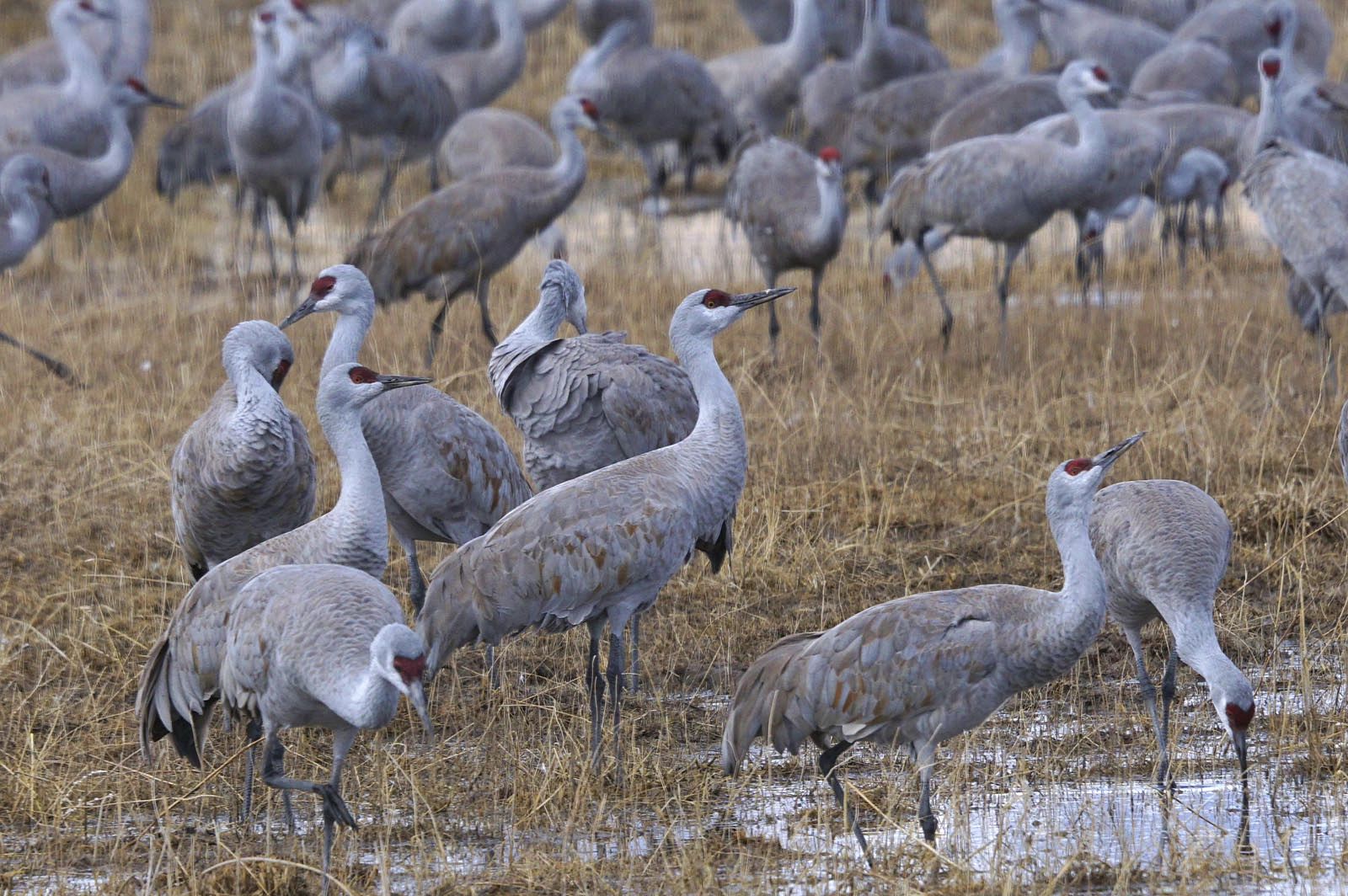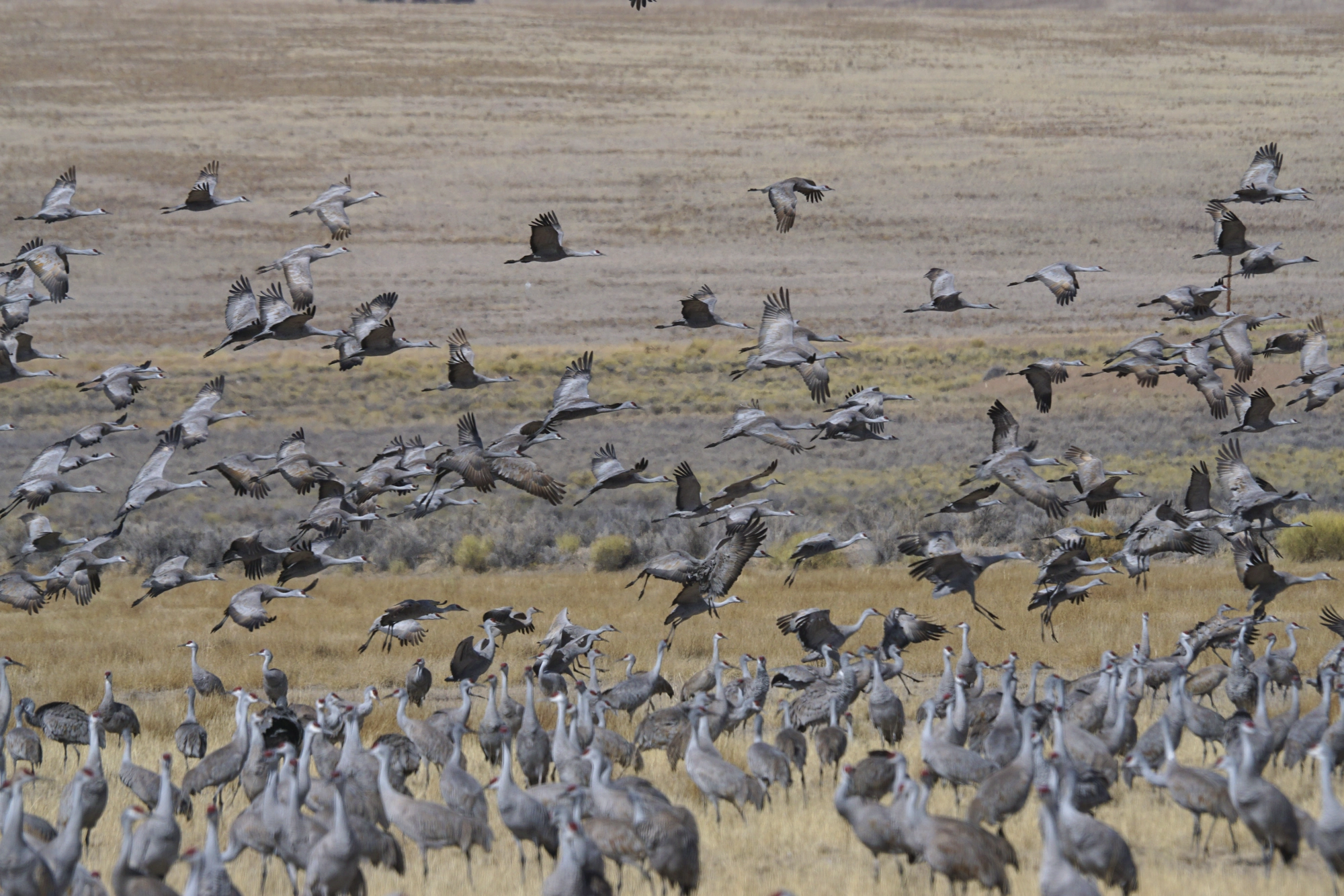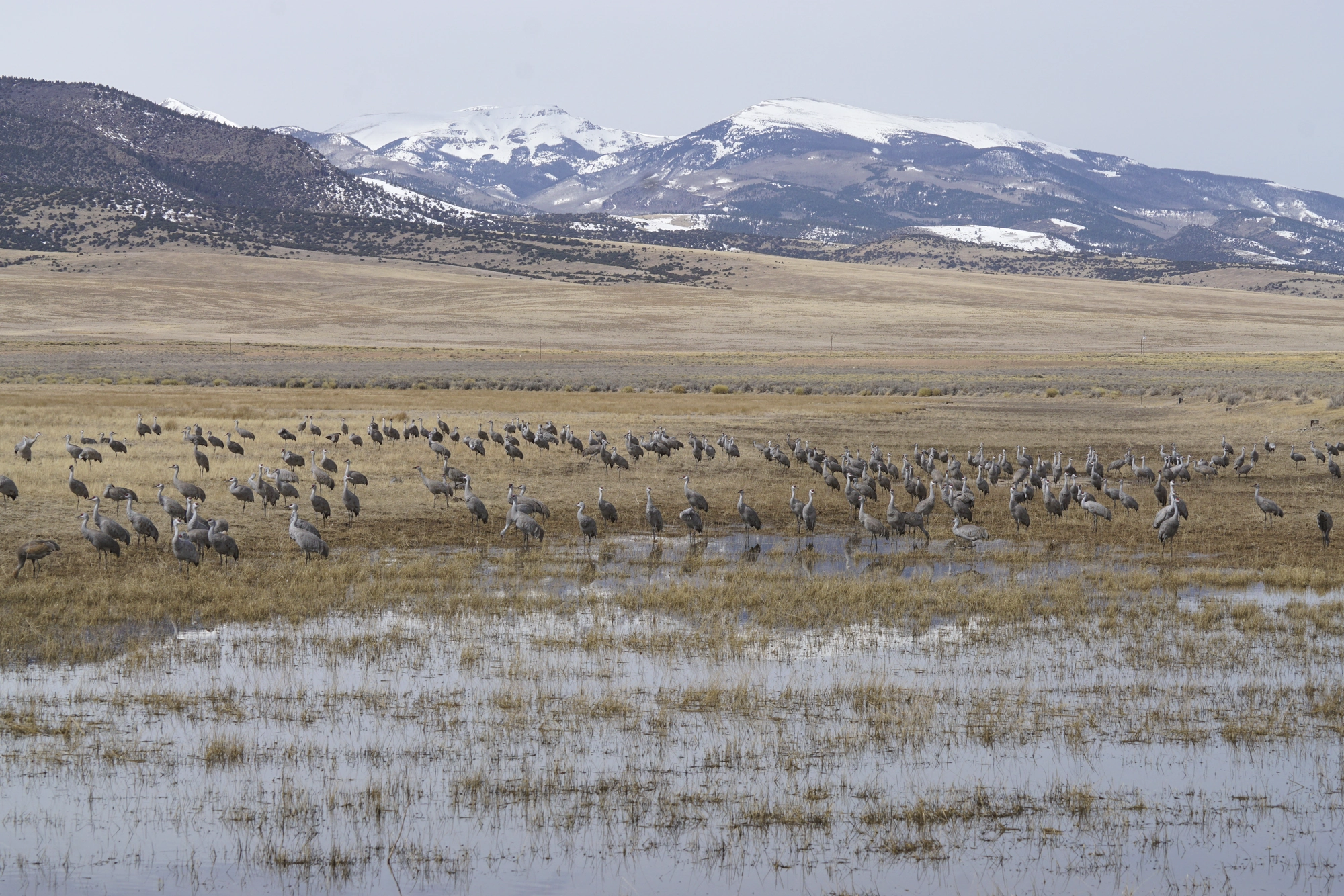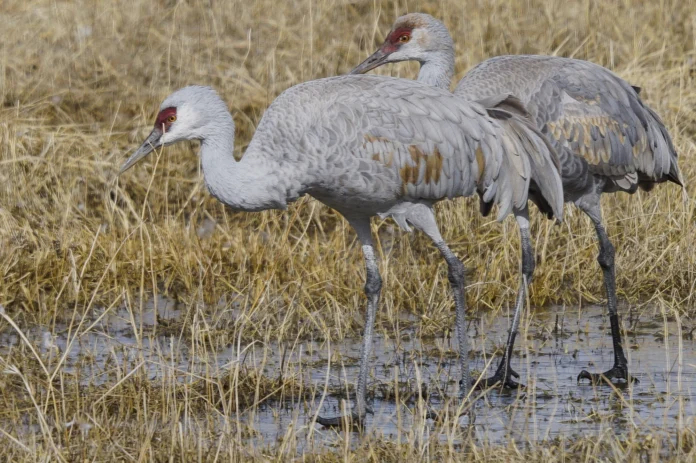Sandhill cranes are as old as the story of migration itself. Tall, gray-bodied, crimson-capped, they move with a purpose that has outlasted ice, drought, and the rise of cities. Fossil evidence places cranes much like today’s sandhills at roughly 2.5 million years old — ancient birds still threading North America along sky-roads older than our highways.
The Two Big Routes — and Where Colorado Truly Fits
Most people picture Nebraska’s Platte River when they think “crane migration,” and fair enough — more than half a million birds pour into the Central Flyway each March, creating one of the continent’s greatest wildlife spectacles. But Colorado tells a different story. The state lies on the Rocky Mountain Flyway, used primarily by the Rocky Mountain Population (RMP) of Greater Sandhill Cranes.
Colorado’s sandhill cranes are not a sideshow to Nebraska. They are a western population with its own corridor, calendar, and conservation math. They arrive mid- to late February, peak early to mid-March, and spend about a month staging in the San Luis Valley before crossing the spine of the Rockies to breed. They return late September through November on the way to the Rio Grande. They migrate because energy budgets and breeding success demand it. And they will keep doing it — if we keep water on the landscape at the right times, defend shallow roosts, and treat working lands as allies, not enemies.

When They Arrive in Colorado — and How Long They Stay
In spring, sandhill cranes begin arriving in the San Luis Valley by mid- to late February. Their numbers peak during early to mid-March, when fields and wetlands come alive with feeding and socializing birds. By late March and early April, most have lifted off, riding thermals and mountain passes toward nesting grounds in Wyoming, Idaho, and Montana.
In fall, the migration runs in reverse. Flocks return to Colorado in late September, with birds stopping through October and into mid- to late November before heading for their winter homes along the Middle Rio Grande in New Mexico or even northern Mexico. Some years, mild weather and available food keep small groups lingering longer.
Why Sandhill Cranes Migrate
Migration isn’t mystery — it’s survival math. Cranes move to follow food and avoid deep cold that locks wetlands and fields in ice. They breed far north, where long summer days and abundant insects, tubers, and sedges let them raise young quickly. As soon as those conditions vanish, cranes follow warmth and open water southward.
Colorado’s role is crucial: the San Luis Valley acts as a refuelling station where cranes rest, fatten up on leftover grain and wetland invertebrates, and gather strength for the next leap. For these long-legged travelers, missing a stopover or finding it degraded can mean arriving at breeding grounds late or exhausted — with fewer chicks surviving the summer.
Life on a Colorado Stopover
At dawn in the San Luis Valley, the sound comes first — a bugling chorus that seems to vibrate in your chest. As light spills across the Sangre de Cristo range, flocks rise from shallow roosts in sheets, turning sky gray with beating wings. They spend the day feeding in barley stubble, alfalfa fields, and wet meadows. Come sunset, the ritual reverses: cranes stream back to safe roosts on open water, their voices echoing long after the last glow fades.
This dance isn’t just beautiful — it’s essential. Every hour spent feeding adds fat reserves needed to push over mountain passes and sustain migration. A stopover rich in calories and safe roosts can make the difference between strong breeding pairs and failed nests.

Climate Change: Shifting Skies and Fragile Stopovers
Cranes are hardy, but migration is a delicate chain. Break enough links, and the journey falters. Today, three forces weigh heavily on the Rocky Mountain Flyway:
- Water and Wetlands Drying Up: Persistent drought and shrinking snowpack are reducing the shallow roosts cranes need. Groundwater pumping and water diversions for agriculture make matters worse.
- Changing Timing: Warmer springs can push birds to migrate earlier, sometimes before food is ready or wetlands are refilled.
- Flexibility With Limits: Cranes adapt by using flooded fields and irrigated meadows, but prolonged dry years can stretch their daily flights between roost and feeding grounds, burning precious energy.
Conservation in Colorado is focusing on keeping water on the land at the right time — through managed wetlands, refuge water delivery, and partnerships with farmers who flood fields when cranes need them most.
Population Health — Numbers Behind the Wings
The Rocky Mountain Population of sandhill cranes is comparatively small, with roughly 25,000–27,000 birds counted in recent surveys. It’s a fraction of the 500,000–700,000 seen along Nebraska’s Platte, but it’s a strong, stable number for this western group. Wildlife managers watch it closely, adjusting hunting seasons and habitat priorities to keep the population healthy.
These Colorado birds winter largely in northern New Mexico and northern Mexico, then return here before crossing the Rockies. Their migration corridor is narrow and specialized — a reason conservationists pay close attention to water, crop practices, and wetland management in the San Luis Valley.
What to Watch For — A Field Guide for Spring and Fall
- Spring Spectacle: The first two weeks of March are prime time. Be in place before sunrise to watch flocks lift from roosts. Return at sunset to see their sky-filling descent.
- Fall Passage: Late September into November brings a more subdued but equally beautiful return flight south.
- Where to Go: The Monte Vista National Wildlife Refuge offers safe, close viewing and mapped auto loops that keep you off fragile fields. Great Sand Dunes National Park and nearby valley farms also provide excellent vantage points.
Remember: those fields are the birds’ pantry. Stay on designated roadsides and keep distance — you’ll see more natural behavior and avoid pushing the birds off food they need.

Why This Migration Matters
Colorado’s sandhill cranes are a testament to resilience. They’ve survived ice ages and human expansion, yet their future depends on how we manage the modern West. Water shortages, habitat loss, and climate-driven timing changes could fracture this ancient route.
But there’s hope. Refuge managers, farmers, and conservationists are collaborating to keep wetlands wet and fields productive when the birds arrive. Festivals and ecotourism bring awareness and dollars that help sustain both the birds and the communities that share their stopovers.
And for anyone who has stood at dawn and felt that rolling, ancient bugle echo across the valley, the work is worth it. These cranes remind us that migration isn’t just flight — it’s a story older than humanity, still written across Colorado’s skies each spring and fall.
References and research
- U.S. Fish & Wildlife Service – Rocky Mountain Population Greater Sandhill Crane Management
- Monte Vista Crane Festival – Official Site
- Colorado Parks & Wildlife – San Luis Valley & Monte Vista National Wildlife Refuge
- Great Sand Dunes National Park & Preserve – Sandhill Cranes
- National Audubon Society – Sandhill Crane Species Profile
- Nebraska Game & Parks – Platte River Crane Migration
- U.S. Fish & Wildlife Service – Central Platte River Crane Survey 2025
- Cornell Lab of Ornithology – All About Birds: Sandhill Crane
- U.S. Geological Survey – Fossil Record of Sandhill Cranes
- Conservation Biology – Hydrological Drought and Surface Water Habitat for Migratory Birds
- ResearchGate – Sandhill Crane Migration and Climate Change
- Birds of the World – Sandhill Crane Overview





